Since the inception of this industry and press-only convention, video game fans throughout the world fantasized about being able to play newly announced games months, or even years, before they hit store shelves. Football fans have the Super Bowl, competitive eaters have Nathan’s International July Fourth Hot Dog Eating Contest, and gamers have E3.
Rather, gamers had E3. Though the gathering is still around, and there are reasons to believe that this year’s convention might be of great interest, it underwent some unpopular changes recently, making the convention of 2006 the last E3 as we knew it.
At that time, I was actively involved with my college newspaper. During the Spring 2006 semester I had been placed as Assistant Arts Editor, and I found every excuse I could to write about the gaming industry. Halfway through the semester it occurred to me that my position in the media could qualify me for access to the Electronic Entertainment Expo. I, along with another editor Eric Iberri, eagerly sent out for a request to register. Despite cutbacks in attendance numbers, we were both approved for registration. We did not know it at the time, but we had just been given the right to attend the most exciting E3 yet for Nintendo fans.
By the time the first day of the convention came around, Nintendo had announced which games would be playable at the Wii’s coming-out party. However, this lack of surprises didn’t make the day any less exciting. If anything, it fueled our anticipation. Knowing that we would be among the first to play games like the newly announced Super Mario Galaxy and Metroid Prime 3 made it surprisingly easy to pull myself out of bed two hours before sunrise so that I would make it to E3 on time.
To avoid L.A. traffic, Eric and I had decided to use two forms of transportation that were new to me: the train and the bus. The latter form of public transportation was by no means a high-class experience, which I’m sure the hobo sleeping in the back could attest to, but after that slightly dirty experience, we had finally made our way to the Los Angeles Convention Center, home of the Electronic Entertainment Expo.
Upon entering the huge building, we promptly made our way to the registration room to inform the staff of our presence and to receive our press badges. Much to my surprise, the badge came attached to a Nintendo lanyard, which featured all of their current systems, including the Wii. To some, this item was simply a way to hang their badge around their neck, but to me it was a precursor to the amazing day that was ahead.
After a short wait, which included a complimentary breakfast and free gaming magazines, we finally made our way into the main hall. The media was allowed into the convention an hour early, so we left the majority of the crowd waiting outside and headed directly for the Nintendo booth.
Unlike most game demos at E3, there was an additional line just to be able to see the Wiis, which Nintendo had enclosed in their own mini-convention. We quickly lined up for a wait that lasted another hour-and-a-half, but at least we were kept entertained. Nintendo had hired multiple people to be displayed on screens on the wall and converse with attendees via a webcam-type setup. That was an interesting enough experience, but as we approached the last screen before the entrance, we were greeted by a familiar voice.
“It’s-a-me, Mario,” we heard Charles Martinet, the voice of many famous Nintendo characters, say. Though we technically did not meet him in person, it was a welcome surprise to be able to converse with the popular actor.
By this point, the media’s extra hour had expired and the remainder of the crowd was allowed in, resulting in a mad-dash to Nintendo’s booth. Luckily, only a few gamers were trampled in the stampede, but the high interest in the Wii had made the line to enter exceed four hours for the majority of the convention.
Shortly after witnessing this crazed entrance, we were finally allowed in. This whole experience was what I imagine entering a popular nightclub would be like. As we were finally granted access to the inside, V.I.P.s were greeted by the bouncers and let inside without any wait. Our senses were bombarded with music turned to 11 and flashing strobe lights sure to cause seizures. Celebrities had their own, roped off, section, where they could relax without having to rub elbows with the commoners. Of course, the whole disco delusion disappeared once I remembered that everyone was here to play video games.
After making our way through displays of the Wii Remote and various conceptual controller shells, including the Zapper, we reached what we had been waiting for: Wii game demos.
Metroid Prime 3 was the closest of the big-name titles, so we queued up to experience the game before the line grew any longer. While we waited, many of us took turns on the adjacent, line-less, WarioWare: Smooth Moves. When I finally had a chance with the game, I eagerly slipped on the precautionary wrist strap and began following the wacky on-screen commands. My first experience with the Wii saw me pumping up a balloon, shaking hands with a Nintendog, and doing the hula.
I returned to the Metroid Prime 3 line, not exactly sure why I was so willing to do such embarrassing activities with a large group of people watching me. As we drew closer to the demo of the first-person adventure game, my focus changed to watching others trying to cope with the controls. This learning experience seemed to help as I finally got my hands on the game and was able to adjust rather quickly to the intuitive, yet initially confusing controls. Unfortunately, the line behind me had grown to walkway-blocking length, so the Nintendo staff had decided to shorten the demo time. Though I was unable to reach the climactic boss fight at the end, the few minutes I had played of the demo had left me enthusiastically awaiting the final game.
After leaving the crowded Metroid demo area, I began to explore the rest of Nintendo’s Wii exhibit. Unfortunately, I could not find the Super Mario Galaxy demo. I began growing concerned that Nintendo had opted to only show the game behind closed doors to select individuals. Since I could not find the highly anticipated Mario game demo, I decided to jump in line for Nintendo’s new racer, Excite Truck. Much like Metroid, this game had a learning curve as I adjusted to the new control scheme, but by the time my race had come to a finish, I was impressed with the unique method of steering.
Luckily, I had spotted the Mario demo while waiting in line for Excite Truck. The game demos continued around another turn, and the demo I sought was in the corner of this region. I willingly waited another hour to experience Mario’s galactic adventure, while Eric chose to try some of the other games like Wii Sports and, his personal favorite, the Japan-only SD Gundam: G Breaker.
Much like with the Metroid demo, the Nintendo staff had decided that the line for Mario Galaxy was too long, so the length of the demo should be shortened for those playing the game…beginning with me. Luckily, the woman working this particular demo was kind of enough to see that I was disappointed with this decision, so she allowed me to reach one of the three possible ends to the demo as long as I hurried.
Since I knew I had to rush, I was concerned that I would be unable to adjust to the game like I had in the previous games. Fortunately, Mario Galaxy’s controls came naturally - a testament to the game’s superior design. I forged my way through the game’s breathtaking environments, areas I would be unable to experience again until Super Mario Galaxy’s release in late 2007, and eventually reached one of the end-level bosses; a huge mechanical character that had to be scaled to find its weak-point.
After this awe-inspiring finale to my Wii experience, Eric and I decided to inspect the rest of the convention. There were some fun times to be had at the rest of the show. The DS had a very strong showing with many new games to be played. I also attempted to have a conversation with the Japanese-speaking composer Hajime Wakai as he watched my experience with his most recent project Star Fox: Command. Even some of the non-Nintendo games being showcased offered some fun times. Despite this, everywhere I went, I heard people talking about the Wii. It was obvious that this year’s E3 was all about Nintendo’s new console.
At the end of the day, we exited the convention center and started our trek back home. I knew that today’s activities were experiences that I would remember for years to come. As I sat down on the train, I was relieved to get off my feet. Waking up in the wee hours of the morning and standing all day had made me unbelievably tired. I knew that my exciting day would be ended by an hour-long train ride, but at least I had a bunch of gaming magazines to read.
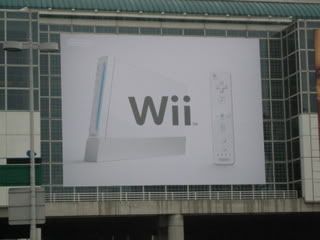
The giant sign greeted attendees from the street
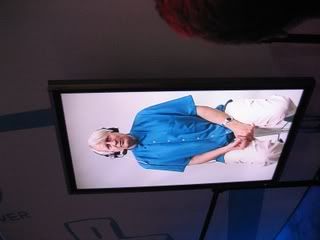
Charles Martinet, best known for being the voice of Mario, chatted with those waiting in line
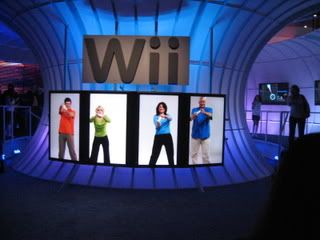
The first sight upon entering the Wii booth
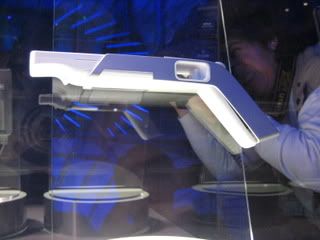
Nintendo displayed an early version of the Wii Zapper
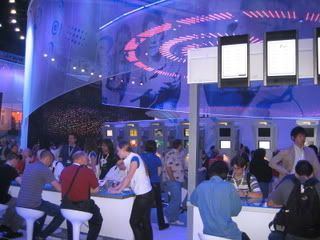
A view of the DS Bar from the outskirts of the Nintendo booth
Thanks to Eric Iberri for the above photos!